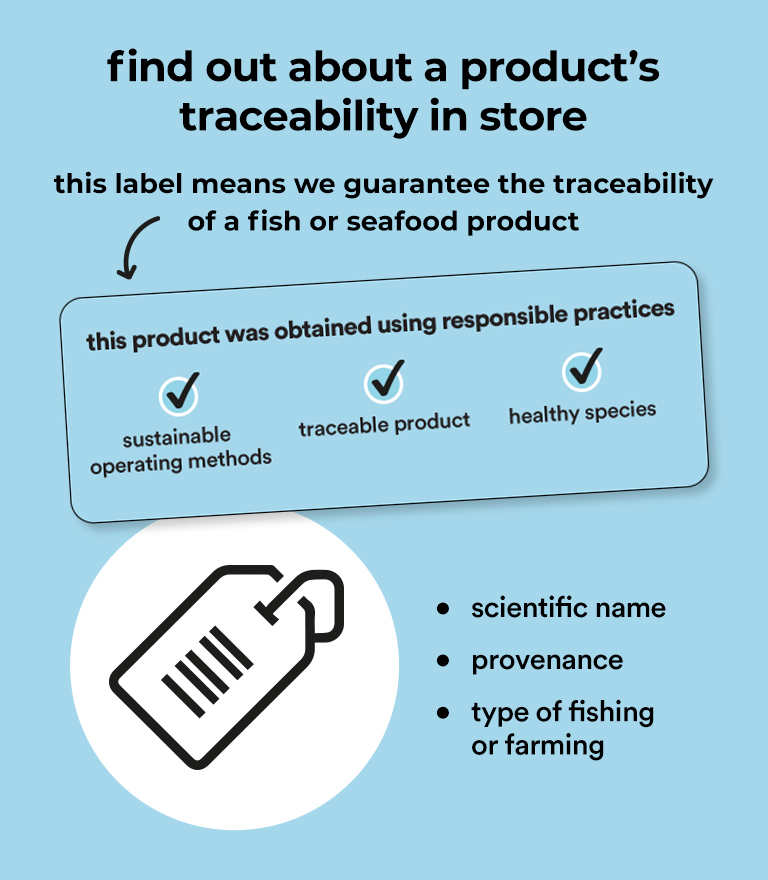our sustainable fisheries and aquaculture policy
Sustainable fisheries and aquaculture products are products that have been caught or farmed using responsible practices that do not endanger the health of the species or the integrity of natural environments, and respect workers' rights.
In 2010, Super C and other members of the extended Metro family adopted a sustainable fisheries and aquaculture policy in order to offer a range of products obtained in a way that does not endanger the oceans or their ecosystems.
We recognize that the health of the oceans and preservation of natural resources are vital. We are also aware that the fishing and aquaculture industries face important issues that concern the sustainability of fish and seafood stocks, the protection of biodiversity and ecosystems, as well as working conditions.
Adopted in 2010, updated in 2018 and again in 2022, our sustainable fisheries and aquaculture policy covers fresh, frozen, and canned fish and seafood. It was developed based on scientific expertise, continuous monitoring of industry issues and trends, and relations with stakeholders interested in the matter. The policy is designed to oversee our procurement practices and foster the adoption of responsible fisheries and aquaculture practices. It is built around five procurement principles.
procurement principles
1 - healthy species
We believe that species health is an integral part of a responsible procurement process.
1.1 wild species
We aim to commercialize wild species caught from healthy stocks whose fishing rates allow for renewal. A stock is considered healthy when it is not subject to overfishing and is not identified as being at risk. The species must be harvested in fishing zones that are well controlled and managed, and, when applicable, by means of quotas covered by the law and based on credible scientific assessments.
By fish stock, we mean a group of individuals of the same species that live within the same geographic area that mix sufficiently to allow reproduction among them and have little contact with other stocks of that species.
1.2 farmed species
We aim to commercialize aquaculture species that are farmed in healthy environments (water quality) which meet the different needs of the species. The practices used should minimize density and ensure that adequate feed is provided in terms of quality and quantity.
2 - responsible operating methods
The fisheries and aquaculture farms that supply us will have to demonstrate that they use responsible operating methods, as well as recognized best practices.
2.1 wild species
For wild species, we favour the use of methods that limit environmental impacts, including on the seabed, as well as selective fishing methods which reduce the volume of bycatch (undesired species that are caught accidentally).
2.2 farmed species
For aquaculture species, we favour practices that minimize environmental impacts, both physically (air, water and soil) and biologically (fauna and flora).
3 - product traceability
Traceability is a central factor in implementing responsible fisheries and aquaculture practices. We place great emphasis on traceability, and have implemented a rigorous traceability system that allows us to document the supply chain from the fishing zone or farm to the consumer.
For each product sold, our suppliers provide us with key traceability information, such as the species' scientific name, provenance, and operating method. We also require all our suppliers to demonstrate their ability to document, when asked, their chain of supply, extending back to the fishing vessel or farm.
Due to this traceability system, we are able to provide customers with informative, transparent labeling.
common and scientific names
Some commonly used names, like "tuna", "shrimp", and "scallops", refer to a number of different species, sometimes hundreds of species. Some of these species may be completely sustainable, while others are not. The scientific names (Latin names) are unique to each species. Using them means we can be sure we are referring to the right species.
provenance
Some species are distributed over a wide geographic area. The stocks must therefore be assessed separately because there is little to no contact between them. As there are marked differences between aquaculture practices, it is also important to identify the product's source.
location
The place of capture (location) is the place where the product is caught or raised, whereas Canadian legislation defines the country of origin as the place where the product was last processed. A fish that was caught in Canada but filleted in China would be labelled as a Product of China. Our detailed labelling clearly identifies where the product comes from.
capture
Identification of the type of capture differentiates between wild and farmed products.
operating method
Knowing the operating method is important because some fishing and farming techniques have much less environmental impact than others.


4 - respect for workers
All suppliers must adhere to the METRO Supplier Code of Conduct for Responsible Procurement, one principle of which is respect for workers, as proof of their commitment to meet these criteria.
5 - socioeconomic development
As per our responsible procurement principles, we hope our sustainable fisheries and aquaculture policy contributes to:
The development of fisheries, aquaculture farms, and local processing facilities in Quebec and Ontario, in line with its local purchasing policy;
The development of small-scale fisheries in areas offering products not available locally.
policy implementation
We have identified specific groups of species that present increased risks in terms of sustainable fishing and aquaculture, either because the stock status is of concern or because of the potential impacts of the operating method used.
For more information about the implementation of this policy, please consult the Our Sustainable Fisheries and Aquaculture Policy section at metro.ca.




